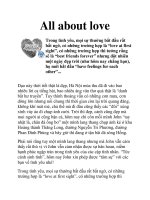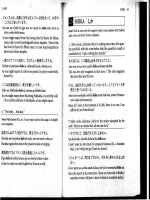All about ocean answers
Bạn đang xem bản rút gọn của tài liệu. Xem và tải ngay bản đầy đủ của tài liệu tại đây (99.87 KB, 1 trang )
4
All About Ocean Life
Activities Answers
Subject Area
Pages 24–25 1 1 Arctic Ocean 2 Pacific Ocean 3 Atlantic Ocean
4 Indian Ocean 5 Southern Ocean 2 1 five 2 70; 3 two 4 30; 5 two
3 1 ocean 2 Arctic 3 warmer 4 coral reefs 5 waves 6 biggest 7 water
4 1 blue whale 2 Arctic 3 Southern 4 currents 5 tides
Pages 26–27 1 1 plant plankton 2 animal plankton 3 small fish
4 dolphin 5 great white shark 2 1 Dolphins eat small fish. 2 Great
white sharks eat dolphins. 3 Whale sharks eat plankton. 4 Sea otters
eat sea urchins. 3 1 They are very small animals and plants.
2 Because they need sunlight. 3 A predator is an animal that eats
other animals. 4 The biggest fish in the world is the whale shark.
5 Kelp is seaweed. 4 free answer
Pages 28–29 1 1 sea anemones 2 mangrove trees 3 limpets 4 shellfish
2 1 animals, seashore 2 low tide 3 rocks 4 shell 5 salt 6 tentacles, dry
out 3 1 Ocean Animals: sea anemones, sharks, animal plankton,
limpets, sea urchins, shrimps, sea otters, whales; Ocean Plants:
mangrove trees, plant plankton, kelp 4 1 a limpet 2 a sea anemone
3 a mangrove tree 4 a shark 5 plankton
Pages 30–31 1 1 milk 2 flippers 3 blowhole 4 two hours 5 eggs
6 bigger wings 2 Mammals: sea lion, sperm whale, blue whale,
dolphin; Birds: albatross; Fish: shark 3 free answers
Pages 32–33 1 1 shark 2 lionfish 3 clownfish 4 sea anemone 5 sea urchin
6 cleaner wrasse 2 1 They are small animals with hard covers: corals
2 They sting predators with their tentacles: sea anemones 3 They
live near the tentacles of sea anemones: clownfish 4 They have
spines that can sting: lionfish 5 They clean other fish: cleaner
wrasse 3 1 false 2 false 3 true 4 true 5 false 6 false 4 1 colors
2 camouflaged 3 skin 4 kill 5 mouths
Pages 34–35 1 1 octopus 2 shoal of fish 3 porcupine fish 4 leafy sea
dragon 5 starfish 6 seaweed 2 1 It grows a new arm: a starfish 2 It
turns a different shape so that nothing can eat it: a porcupine fish
3 It makes a cloud of black ink: an octopus 4 It hides in seaweed: a
leafy sea dragon 5 They swim together in big groups: a shoal of fish
6 It turns a different color: an octopus 3 1 They are called shoals.
2 It looks like seaweed. 3 They camouflage themselves by turning a
different colour. 4 They make a big cloud of black ink. 5 It drinks lots
of water. 6 It gets big and round like a ball. 4 free answers
Pages 36–37 1 shark 2 nostril 3 teeth 4 jellyfish 5 tentacles 6 angler
fish 7 light 8 head 9 eye 2 1 prey 2 head 3 television 4 tentacles
5 dark 6 head 3 1 It gives fish an electric shock: electric ray 2 It can
see and smell all around: hammerhead shark 3 It stings fish with its
tentacles: jellyfish 4 It has a light on its head so other fish swim near:
angler fish 4 free answers
Pages 38–39 1 1 bird 2 polar bear 3 seal 4 penguin 5 whale 6 dolphin
2 1 a lot of 2 summer 3 biggest, small 4 food 5 South 6 feet 3 1 polar
bears: any three from They live in the Arctic, Most of the year they live
on ice, They catch seals from holes in the ice, They swim between
the ice and icebergs, They are the biggest type of bear, Their cubs
are very small plus free answer; penguins: any three from They live near
the South Pole, They dive into the ocean for fish and other small
animals, They have special feathers that keep them warm and dry,
Their feathers sometimes make them too hot, They keep their eggs
on their feet plus free answer
Pages 40–41 1 1 fish 2 pearls 3 ice cream 4 seaweed 5 oysters 2 1 false
2 true 3 false 4 false 5 true 6 true 3 1 oysters 2 shell 3 ropes 4 Pearls
5 money; 3, 2, 5, 4, 1; 6 grows 7 collects 8 dries 9 sells 10 put; 9, 8, 6,
7, 10
Pages 42–43 1 1 oil 2 chemicals 3 plastic bags 4 fishing nets
5 Marine parks 2 1 Because birds and other animals eat it and it
gets onto their skin or feathers, and it can kill them. 2 Because
they look like jellyfish when they’re in the water and sea turtles
eat them. 3 Sometimes, they catch dolphins, sea turtles, seals, and
birds. 3 Pollution: dirty water and chemicals, people leave things
on beaches, oil; Fishing: big nets catch animals, fishermen take too
many fish; Damage: boats break coral reefs 4 1 There are new rules
so people can’t take too many fish from the ocean. 2 There are new
types of fishing net, which big animals can swim out of. 3 There are
marine parks where the ocean is always clean and safe.
The Natural World
Topics & Curriculum Links
oceans and the environment (Science; Civics)
oceans around the world (Geography)
plants and animals (Science)
food chains (Science)
classification (Science)
parts of the body (Science)
sizes and measurements (Mathematics)
Vocabulary
oceans; animals; plants; places; food; parts of the body;
numbers; seasons; measurements
Grammar
present simple; present continuous; past simple;
question forms; adjectives; prepositions; adverbs
Teaching Ideas
See also pages 6–7 for general ideas that you can adapt.
Or go to www.oup.com/elt/teacher/readanddiscover
READ
& TALK An Ocean Animal
After completing Chapter 4 and the activity on page 31
of the Reader, students present their animal to the class,
without saying its name. They can talk about it like this:
It’s a mammal / fish / bird. It eats ... It lives ... It has ... It’s ... It can
... Students then guess which animal it is. Or students ask
questions, for example: Is it a mammal / fish / bird? What
does it eat? Where does it live? How big is it? What does it look
like? Students can also do this with other ocean animals
from the Reader.
Oceans in Danger Posters
After completing Project 1, students choose one of the
dangers and make a poster about it. Students can work in
groups, and posters can then be displayed together.
Ocean Research
Using books or the Internet, students do research on oceans,
for example, to find out the size of oceans, the countries
near them, the islands in them, or which animals live there.
They can write about their findings and add pictures. They
can also use a copy of the world map on page 7.
PHOTOCOPIABLE
© Oxford University Press
16
Oxford Read and Discover
●
Teaching Notes
20









